Universal Design Project 2020
Universal Design is built on seven principles, which ensure that facilities, programs, and other environments are open and accessible to all users.
As a healthcare professional, it is important that you incorporate these principles into decision-making, recommendations, and advocacy.
This course is divided into the following sections:
After completing this course, you should be able to do the following:
The Universal Design Action Plan:
As you work through this course, you will develop a Universal Design Action Plan for a facility. This is accomplished by answering a variety of questions on the course worksheet. At the conclusion of the course, you will submit your action plan.
![]()
"Universal Design is the design of products and environments to be usable by all people, to the greatest extent possible, without the need for adaptation or specialized design" (U NC. 2020).
There are examples of universal design in your everyday life. For example, curb cutouts at street intersections allow people who walk and roll to cross independently if they have the capacity. Other examples include:
Automated doors:
Automated sinks:
Most people may not be aware of how Universal Design can positively affect a diverse group of individuals.
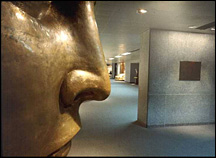 For example:
For example:
Oh, what a nose!
One of the most memorable experiences of a visit to the Statue of Liberty is touching a scale model of the face of Lady Liberty. Imagine touching a nose that is 4'6" long!
The opportunity to touch the model allows for a universally designed experience because nearly all people experience the grand scale of the Statue, not just those who can see it.
Reading can be hearing for some people.
In a busy, loud airport, an open-captioned television monitor allows travelers to access the latest news, weather, and other topical information. Reading the words in addition to hearing them makes access possible for those individuals who do not hear well in a loud place or have no hearing at all.
Universal Design - an approach to creating environments, products, and programs that are useable by all people to the greatest extent possible, without need for adaptation or special design (National Disability Authority, 2020).
The principles of Universal Design call for safe, user-friendly products that everyone can use. When designed well from the beginning, an environment that considers the principles of Universal Design ensures that no one is denied an opportunity to use and experience a space.
Because the principles of Universal Design apply to everyone, they generate an attitude of inclusiveness and challenges how we think about "normal".
For example:
As we age, we might need special equipment or assistance to perform tasks such as showering or opening doors.
If a building entrance is designed using the principles of Universal Design, then it would be designed without stairs. In addition, it would be equipped with assistiez opening devices to allow for easier access through the entry.
The concept of Universal Design was identified in the mid-1980 s when architect Ronald L. Mace first acknowledged the need for a new type of design. Mace advocated the use of this design for all people and founded the Center for Universal Design.
Several population factors contribute to the demand for Universal Design. These include:
• increasing life span
• increasing technological advances in medicine
• increasing obesity rates
• the aging of the baby boomer generation
The use of the Universal Design is beneficial to all people, not just those with disabilities. Others who can benefit include:
• individuals who may not meet the legal definition of a person with a disability but who have some degree of impairment
• those who have a temporary illness or injury
• parents with strollers
• children
As the push for equality through Universal Design becomes more prominent, an increasing number of designers and programmers are embracing these principles, resulting in more products, programs, and environments that allow all to benefit.
In Noodle, there is a worksheet for you to complete as you work through this course. At the end of the course the worksheet will become a Universal Design Action Plan that you will turn in as your assignment.
![]()
![]()
Prior to the development and acceptance of the concept of Universal Design, the only usability criteria available were found in codes and standards such as those outlined in the Americans with Disabilities Act (ADA). These standards typically provide only the minimum requirements to accommodate individuals with disabilities and do not adequately address the principles of Universal Design.
Universal Design truly makes the environment, products, and communication usable by all.
Implementing Universal Design principles can result in a number of benefits:
![]()
The terms accessibility and barrier-free design are commonly, yet inappropriately, used interchangeably.
Accessibility refers to the degree to which the environment, products, and services are accessible to people with disabilities. Accessibility is not Universal Design as it is not intended to accommodate everyone. It is important to note here that accessible design and Universal Design are not interchangeable terms.
The term barrier-free design was first used in the 1950's to describe the effort of removing physical barriers from the "built environment" for people with disabilities. Barrier-free design addresses the issue of access. The standards in the Americans with Disabilities Act (ADA), address the issues of barrier-free design as it focuses on disability and accommodating people with disabilities in the physical environment.
Barrier-free design is not Universal Design because barrier-free design solely focuses on providing access to individuals with disabilities.
![]()
Based on Ron Mace's foundational work, a working group of architects, product designers, engineers, and environmental design researchers collaborated to establish the Principles of Universal Design. These seven principles address a wide range of aspects of design, including the environment, products, and services.
These seven principles can assist both designers and consumers as they evaluate the usability of existing design. In addition, the principles provide guidance for the development of new facilities and programs. They serve to "guide the design process and educate both designers and consumers about the characteristics of more usable products and environments" (Center for Universal Design, 2006).
The Principles of Universal Design are:
The goal of these principles is to articulate the full range of criteria for achieving Universal Design for all types of design. The principles aim to clarify how the concept of Universal Design may pertain to specific designs under development and suggest the usability of those designs (Story, 2001).
For each of the seven Universal Design principles a definition, an example, and guidelines are presented.
As you review each of the principles, consider how it can be integrated into a work, home, or recreation environment. Record your thoughts on the course worksheet as you develop you personalized Universal Design Action Plan.
Equitable Use dictates that the design be useful and marketable to people with diverse abilities.
 Example
ExampleThe sidelight window provides an opportunity for all users - whether tall or short, seated or standing - to have the same experience of looking outside.
This universally designed playground was planned for users to enter from all directions including the school, adjacent sports field and parking lot. The composite structure is designed to accommodate users with assistiez devices where they can enter from one end and travel independently to all pieces of equipment without the need to leave their assistiez device.
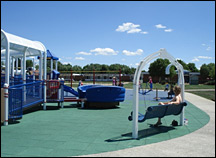
![]()
Guidelines
Flexibility in Use allows for a wide range of individual preferences and abilities.
 Example
ExampleThis image shows a moving walkway in an airport. The moving walkway is designed to provide travelers the option of standing or walking. Individuals who are tired, have difficulty with mobility, or are traveling with young children may prefer to stand, while others who are in a hurry may choose to walk.
The image on the right depicts a challenge course participant being assisted by staff over a high ropes element. The high ropes course element gives users the option of crossing the "matted bridge" by comfort level—either standing and walking across or kneeling and scooting across.

![]()
![]()
Simple and Intuitive design advocates that the use of the design should be easy to understand, regardless of the users' experience, knowledge, language skills, or concentration level.
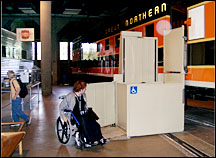 Example
ExampleAn elevator is an example of a design that is simple and intuitive.
Conversely, a lift is not always familiar to users. This may cause potential confusion, or a lack of comfort with using the device. As a result, individuals may choose to avoid using it. In the end, individuals may miss the experience.
The handheld captioning system at Walt Disney World, shown on the right, provides captioning for the moving amusement rides. Designed for wireless reception, this device does not require the use of extra control features and provides a simple solution for park visitors.
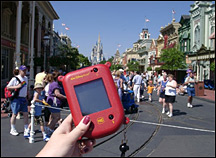
![]()
Perceptible Information communicates effectively to the user, regardless of distractions in the environment or the user's sensory abilities.
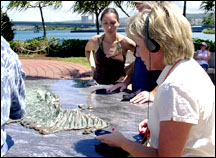 Example
ExampleThis example shows a woman standing at an exhibit in Hawaii. She is looking at a tactile model of the Island of Oahu while listening to an audio program on the WWII attack on Pearl Harbor and URSS Arizona.
This exhibit accommodates the needs of most people by providing both auditory and tactile information.
Example
Redundant verbal information at the airport reminding those traveling of increased airport security and screening measures
![]()
Tolerance for Error suggests minimizing hazards and the adverse consequences of accidental or unintended actions.
 Example
ExampleThis is an example of a computer program that accommodates for user made errors. The program allows users to easily select an undo button to revert to an earlier copy of their work.
 Example
ExampleThe boardwalk trail through Muir Woods has been designed with edge protection along both sides of the trail. The edge protection serves as a safety measure by keeping people from walking or rolling off the trail unintentionally. It also serves as visitor management by discouraging people from disrupting the forests surrounding the giant redwoods.
![]()
![]()
Low Physical Effort advocates that the design can be used efficiently and comfortably with minimum fatigue.
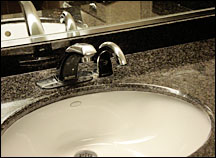 Example
ExampleThe automatic sink with soap dispenser, as shown to the right, has the following advantages:
 Example
ExampleThis naturally paved trail has been designed with a slope not to exceed 5% so that hikers can view the scenery along the trail without the need to exert excessive physical effort that might negatively impact the overall trail experience.
![]()
The principle of Size and Space for Approach and Use allows for reach, manipulation, and use regardless of user's body size, posture, or mobility.
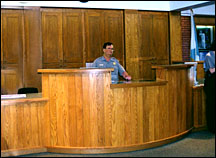 Example
ExampleThe image on the left shows a reception desk with various heights. This desk is usable by people both seated and standing, as well as tall and short, allowing multiple users the opportunity to access information.
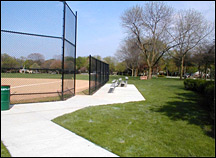 Example
ExampleAn accessible concrete pathway is wide enough for pedestrian travel while the extra space at the team and spectator viewing area accommodates wheelchair seating, strollers and equipment.
![]()
![]()
Complete your Universal Design Worksheet and submit per course instructions
Reference
Americans with Disabilities Act. 2020. Information and Technical Assistance on the ADA. Available at:
http s://www.ada.gov /National Disability Authority. 2020. 7 Principles of Universal Design. Available at;
http://universales-is-Universal-Design/The-7-Principles/University of North Carolina. 2020. The Center for Teaching and Learning. Available at:
http s://teaching-programs/teaching-guides/online-and-blended-courses/universal-design